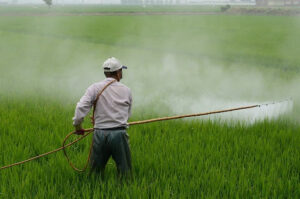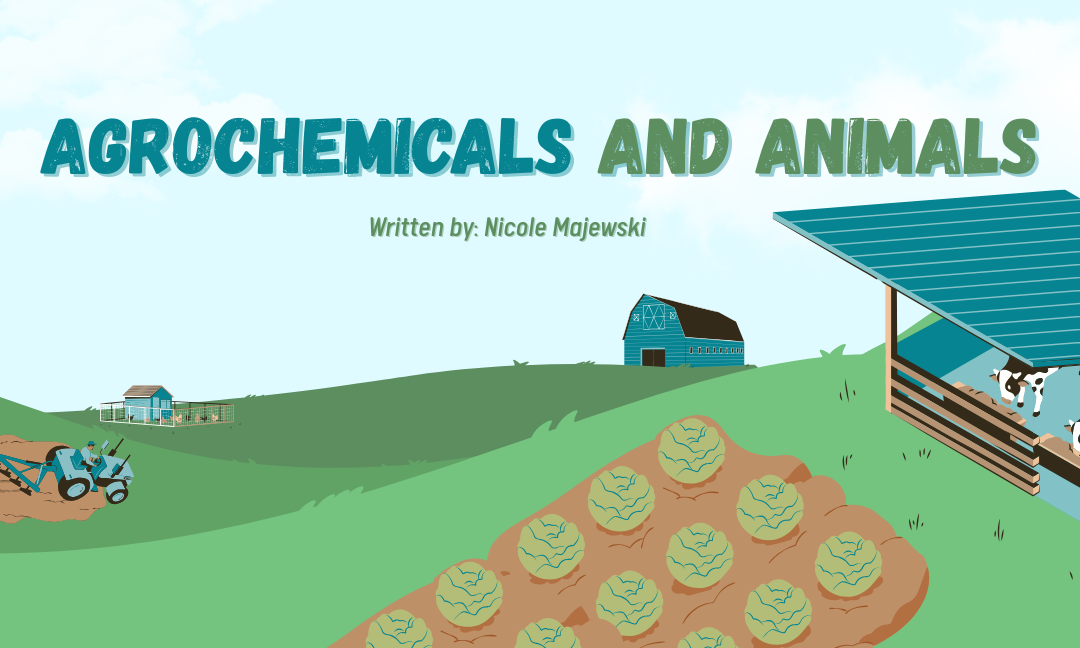Written by: Nicole Majewski
Edited by: Eleanor Jeavons
Designed by: Andria Sahar
Published by: Eleanor Jeavons

You’ve probably heard that pesticides and fertilisers are harmful to the environment, or that they contribute to global warming. If so, you were probably surprised—after all, don’t all farmers use them? Unfortunately, it’s true, and what most people don’t know is that it doesn’t stop there. While agrochemicals—the category of chemicals typically used on farms—can provide short-term benefits, they also pose serious long-term threats. These dangers affect Earth and us. Even more concerning, though, is just how much they can harm animals, especially livestock. In other words, the very chemicals used to boost farm productivity may be quietly hurting the animals that live on those same fields. Today, we’ll take a look at the alarming links between agrochemicals and animals.
What are Agrochemicals?
Before we get into the specifics of agrichemicals, it’s important that you know what they are. Agrochemicals are a category of synthetic substances (like pesticides, herbicides, fungicides, and fertilizers) that are widely used in modern agriculture. They’re meant to improve crop yield, prevent pests, and enhance soil fertility. Because of these benefits, widespread usage of them has become the norm. Recently, though, society has begun to consider an important question; what are the drawbacks?
Agrochemicals and Livestock
Despite how standard agrochemicals have become on farms, research has increasingly begun to warn us of the consequences they could have on the health of the animals. These risks come in many forms, but they can largely be separated into three main categories:
1. Physical Impacts
Agrochemicals can cause serious damage to organs and other internal structures. This is most commonly seen in the liver and kidneys, with their structure sometimes being completely altered. Neurological symptoms have also been reported, which are caused by the chemical makeup of these substances. Their compositions give them the very real—and very dangerous—potential to interfere with the natural chemicals in animal brains. As a result, animals can experience disturbances like seizures or an irregular heartbeat.
These changes aren’t always as immediately visible, though. Agrochemicals can compromise animals’ immune responses, making them more at risk of disease. They can also cause dysfunction in metabolic processes—or how the animals’ digestive systems break down food—which could cause diabetes. Reproductive systems may also be affected, resulting in poor fertility. For example, in chickens, this can cause them to lay eggs that aren’t able to hatch or even develop.
In severe cases, these overlapping impacts can even lead to death.
2. Hormonal Disruption
Even more commonly reported are the effects on animals’ endocrine systems, which control hormone production and regulation. Animals have special hormone receptors inside their cells that allow their bodies to properly transport the hormones they need in order to function normally. However, toxic chemicals can interfere with these natural pathways, just like how they can interfere with neurological function.
Agrochemicals can block hormone activity, or do the exact opposite by overstimulating it, leading to too many hormones being produced. Either path can lead to behavioural issues like increased aggression or altered social behaviour. These hormonal imbalances can also affect growth and development, resulting in irregular patterns.
Worryingly, this isn’t limited to specialised or disproportionately toxic substances—even commonly used chemicals have been found to trigger these effects. This raises serious questions about how much agrochemical exposure is silently harming livestock without our awareness.
3. Other Risks
One of the most dangerous aspects of agrochemicals is their ability to accumulate over time, creating even more risk of dietary and water ingestion by grazing animals. For example, in pigs and cattle, contaminated feed has previously resulted in significant reproductive and behavioural disruption.
If you’re like me, you’re probably asking yourself, “Why don’t we just stop using these chemicals?” Unfortunately, many of these chemicals—especially pesticides—are so strong that even after farmers stop using them, their effects can remain in the soil for decades longer. So, even once a farmer learns of their dangers, it’s often too late to immediately prevent them.
Agrochemicals and Wildlife
These chemicals can also impact animals off the farm. Even if agrochemicals like fertilizers or pesticides are carefully applied to a specific area, soil runoff can lead to these chemicals ending up in unintended places, like nearby ecosystems. Once the surrounding soil becomes contaminated, its impacts are almost instant. Earthworms, for example, can die off, which degrades soil quality even further. Insects, too, are impacted—and these insects are often eaten by birds, passing toxins up the food chain.
Speaking of the food chain, the effects seem to pass all the way up. In larger predators like caimans, some agrochemicals have been shown to decrease birth rates because of damage caused to laid eggs. However, these impacts on reproduction are even more severe in fish, who rely on sending special signals to other fish in the water in order to mate. When chemicals disrupt hormones, they can also disrupt their ability to produce these signals, which can be detrimental to their natural cycle of reproduction.
The Indirect Danger of Agrochemicals
Again, it’s important to understand that all the impacts of agrochemicals are immediate or visible. Some chemicals can alter animal DNA, but these genetic changes will usually only be noticeable in later generations. So, even if the exposed animal seems healthy, their offspring could suffer from developmental issues. These changes are even more long-lasting when the chemical exposure occurs during an animal’s pregnancy, and effects can be carried across many generations.
Agrochemicals and Us
The ripple effect eventually reaches us. Our reliance on animal products—meat, milk, and eggs—means we’re also exposed. On top of the risks to animal health, chemical residues can make their way into the food we consume. So even when we’re not the plants intentionally exposed or the animals unintentionally so, we still become part of the chain of impact.
Conclusion
Agrochemicals have been deeply integrated into modern farming, but their dangers go far beyond what we can see. Livestock, wildlife, and even future generations of animals suffer consequences that often go unnoticed until it’s too late. And even as these chemicals accumulate in our environments and our food chains, the damage doesn’t stop with them—it affects us, too. It’s time we seriously reconsider the long-term tradeoffs of using agrochemicals and fight for more sustainable practices.
References
Baars, A. J. (1990). Abuse of pesticides: Effects on farm animals and birds. Tijdschrift voor Diergeneeskunde, 115(15-16), 720-726. https://pubmed.ncbi.nlm.nih.gov/2396244/
Galbiati, V., Buoso, E., d’Emmanuele di Villa Bianca, R., Di Paola, R., Morroni, F., Nocentini, G., Racchi, M., Viviani, B., & Corsini, E. (2021). Immune and nervous systems interaction in endocrine disruptors toxicity: The case of Atrazine. Frontiers in Toxicology, 3, Article 649024. https://doi.org/10.3389/ftox.2021.649024
Manfo, F. P. T., Mboe, S. A., Nantia, E. A., Ngoula, F., Telefo, P. B., Moundipa, P. F., & Cho-Ngwa, F. (2020). Evaluation of the effects of agro pesticides use on liver and kidney function in farmers from Buea, Cameroon. Journal of Toxicology, 2020, Article 2305764. https://doi.org/10.1155/2020/2305764
Miranda, R. A., Silva, B. S., de Moura, E. G., & Lisboa, P. C. (2023). Pesticides as endocrine disruptors: Programming for obesity and diabetes. Endocrine, 79(3), 437-447. https://doi.org/10.1007/s12020-022-03229-y
Mohammadi, H. (2024, June 20). The impact of pesticides and herbicides on livestock and human health. Zehab SD. Retrieved July 30, 2025, from https://zehabsd.com/blog/environmental-engineering-4/the-impact-of-pesticides-and-herbicides-on-livestock-and-human-health-124
National Pesticide Information Center. (2023, September 27). Pesticides and animal health. https://www.npic.orst.edu/health/animhealth.html
Pritsos, C. A., Moye, J. K., Perez, C., & Hooper, M. (2009-2012). Agrochemical impacts on human and environmental health: Mechanisms and mitigation. University of Nevada. Retrieved July 30, 2025, from https://portal.nifa.usda.gov/web/crisprojectpages/0219145-agrochemical-impacts-on-human-and-environmental-health-mechanisms-and-mitigation.html
Ren, X.-M., Kuo, Y., & Blumberg, B. (2021). Agrochemicals and obesity. Molecular and Cellular Endocrinology, 515, Article 110926. https://doi.org/10.1016/j.mce.2020.110926
Sekhotha, M. M., Monyeki, K. D., & Sibuyi, M. E. (2016). Exposure to agrochemicals and cardiovascular disease: A review. International Journal of Environmental Research and Public Health, 13(2), 229. https://doi.org/10.3390/ijerph13020229
Tavalieri, Y. E., Galoppo, G. H., Canesini, G., Luque, E. H., & Muñoz-de-Toro, M. M. (2020). Effects of agricultural pesticides on the reproductive system of aquatic wildlife species, with crocodilians as sentinel species. Molecular and Cellular Endocrinology, 518, Article 110918. https://doi.org/10.1016/j.mce.2020.110918
Vickneswaran, M., Carolan, J. C., Saunders, M., & White, B. (2023). Establishing the extent of pesticide contamination in Irish agricultural soils. Heliyon, 9(9), e19416. https://doi.org/10.1016/j.heliyon.2023.e19416
Warner, G. R., Mourikes, V. E., Neff, A. M., Brehm, E., & Flaws, J. A. (2020). Mechanisms of action of agrochemicals acting as endocrine disrupting chemicals. Molecular and Cellular Endocrinology, 502, Article 110680. https://doi.org/10.1016/j.mce.2019.110680
Yang, C., Song, G., & Lim, W. (2020). Effects of endocrine disrupting chemicals in pigs. Environmental Pollution, 263(Pt B), 114505. https://doi.org/10.1016/j.envpol.2020.114505
Image References
(2017). Herbicide avignon in rice field [Photograph]. GetArchive. https://itoldya420.getarchive.net/amp/media/herbicide-avignon-in-rice-field-5fa257

